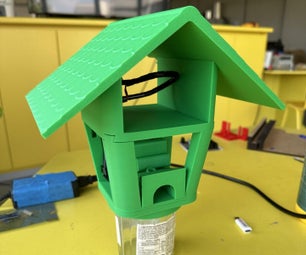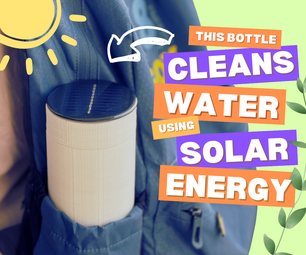Introduction: Increasing Current on 78xx Series Regulators
Typically 78xx series regulators have a maximum load current capacity of 1 to 1.5 Amperes. Using this design you can double the maximum current of your 78xx regulator. This design was posted on the Net by I Hakki Cavdar of Karadeniz Technical University, Trabzon, Turkey. I have revised some of the components values due to heating concerns and to suit my intended application. Picture #2 is the schematic diagram.
Step 1: Preparing the Components & Circuit Board
Component List:
IC1 and IC2 - 78xx series regulator IC ( 7805 for 5V, 7812 for 12V etc.)
D1,D2 & D3- 1N4003 ( 3 Amp Diodes )
D4 & D5 - Light Emitting Diodes (LED)**
R1 & R2 - 4.7 K , 1/2 watt resistor **
C1 & C2 - 4700 uF / 16V electrolytic capacitor
C3 - 47,000 uF / 35V electrolytic capacitor
Printed Circuit Board ( PCB )
Etching Solution
WaterProof marker
** - optional components
Cut the Circuit Board using a hacksaw, click the picture for a better view. Using the waterproof marker, draw this to the copper side of the circuit board- copy the RED diagram. Take note of the pin distances of the components so that placing them afterwards will be a breeze. Put the PCB in the Etching solution and wait until you'll see the copperless plate ( around 20 minutes ). Rinse the PCB with water. Clean the Marker Ink with Acetone to expose the copper. Drill the holes for the components and your PCB is ready to go.
IC1 and IC2 - 78xx series regulator IC ( 7805 for 5V, 7812 for 12V etc.)
D1,D2 & D3- 1N4003 ( 3 Amp Diodes )
D4 & D5 - Light Emitting Diodes (LED)**
R1 & R2 - 4.7 K , 1/2 watt resistor **
C1 & C2 - 4700 uF / 16V electrolytic capacitor
C3 - 47,000 uF / 35V electrolytic capacitor
Printed Circuit Board ( PCB )
Etching Solution
WaterProof marker
** - optional components
Cut the Circuit Board using a hacksaw, click the picture for a better view. Using the waterproof marker, draw this to the copper side of the circuit board- copy the RED diagram. Take note of the pin distances of the components so that placing them afterwards will be a breeze. Put the PCB in the Etching solution and wait until you'll see the copperless plate ( around 20 minutes ). Rinse the PCB with water. Clean the Marker Ink with Acetone to expose the copper. Drill the holes for the components and your PCB is ready to go.
Step 2: Drawing in the Copper Clad Board
Draw the circuit pattern on the copper side using a waterproof marker. The other picture is what it looks like in the other side.
Step 3: Etching
After proof reading your drawing,soak it in the Etching Solution.I am using Ferric Chloride to do it.
Step 4: After Etching
The copper drawn with the marker remains. Clean it with Acetone to get rid of the marker ink and expose the copper.
Step 5: Drilling
Drill the component holes and your done with the PCB.
Step 6: Placing and Soldering the Components
In placing the components, I always place the resistors first, in this case R1 and R2. Next are the capacitors C1, C2 and C3, please always check the polarities of their pins (you can check this by reading the plastic covering of the capacitor, usually its there) to avoid your capacitor blowing up. You might not want a hot liquid and lots of paper shreds in you face. Next, is to insert the LEDs D4 and D5, again take note of their pin polarities (anode and cathode), this won't blow if polarities are not correct, only that it won't light up. Lastly insert diodes D1,D2,D3 and the 2 regulators.
Once all the components are in place, double check their polarities again and your ready. Place the PCB upside down exposing the copper side with the component pins. In my experience, its better to solder the components first before cutting the excess pins but some people I know are more comfortable cutting the pins first before soldering, so this one depends on your liking. Clean all excess pins protruding from the soldered area and your ready for testing your project.
Once all the components are in place, double check their polarities again and your ready. Place the PCB upside down exposing the copper side with the component pins. In my experience, its better to solder the components first before cutting the excess pins but some people I know are more comfortable cutting the pins first before soldering, so this one depends on your liking. Clean all excess pins protruding from the soldered area and your ready for testing your project.
Step 7: Testing and Other Mods
This circuit is very easy to test, just connect a power supply to the input at C1. Note that input voltages should be higher than your desired output.For example, if you want a 12V output, your input voltage should be like 16 Volts or higher -- the 78xx regulator can handle input voltages up to 35V. If everything goes well, your 2 LEDs will light up. If it doesn't, check if there are any voltage coming from your output with a Multimeter then check the LED's pins. The output of this circuit is dependent on your 78xx series regulator, say you connected a 7812 regulator, output should be in the range of 11.3 to 11.5 Volts. I have added sufficient heatsink to prevent overheating of the regulator. I connected this to my wireless router and stayed stable after powering it up for 2 days straight. I found a small CPU fan and added it to reduce heat even further, although its not necessary, might as well make use of it.










